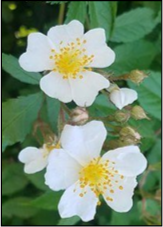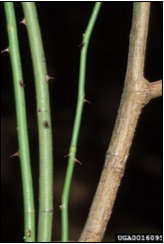Rosa multiflora
By Victoria Wallace, Alyssa Siegel-Miles, and Klaudia Sowizral, UConn Extension
Identifying Features
- OVERVIEW: Multiflora rose is an invasive shrub that grows to 10-15 ft tall and 9-13 ft wide, forming impenetrable thickets.
- LEAVES: Compound, with 5-11 (usually 7-9) leaflets. Leaflets are dark green and smooth on the upper surface; paler with short hairs on the underside. The base of each leaf stalk bears a pair of fringed stipules, which distinguish multiflora rose from native rose species.
- STEMS: Juvenile stems are green with red thorns, which mature to brown. Arching branch habit allows tips of stems to bend to the soil surface, where they can take root and form new (clonal) plants.
- FLOWERS: White to pinkish five-petaled flowers, which open in May and June; 0.5 to 1.5 in. in diameter. Occur in branched clusters.
- SEEDS: Tan to yellow; up to .16 in. Seed germination rates are high - up to 90% in the absence of drought and stress. Seed remains viable for up to 20 years.
- FRUITS: Bright red, smooth hips. Fruits form in clusters after flower blooms during the summer and persist on plant through the winter.
- REPRODUCTION/SPREAD: Plants can produce up to 500,000 seeds per year, which are eaten and spread by birds. Can also reproduce vegetatively from the canes (layering) and root sprouts.
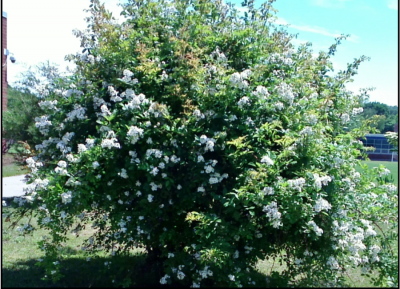
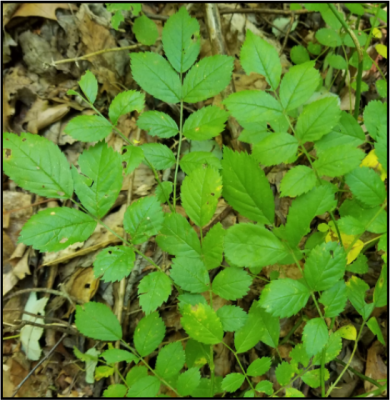
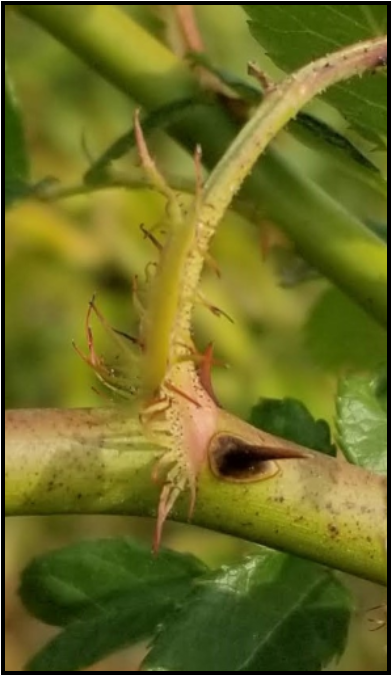
Habitat
Multiflora rose thrives in full sun and well-drained, infertile soils. It is known to proliferate in pastures, field edges, and along roadsides. Multiflora rose can also persist in part shade, although flower and fruit production is less abundant.
Control
A combination of control tactics is necessary to manage this plant. The optimal time for eradication success is right before the plant flowers. A long-term management plan, including continued follow-up maintenance, is critical to prevent reinfestation or new establishment by seed.
MECHANICAL:
- Pulling, digging, cutting, and mowing may be viable components of a control strategy. Seedlings may be hand pulled. Small plants may be removed by digging, ensuring that the entire root crown is extracted to prevent regrowth. Cut back top growth of established plants to enable easier removal of the root crown (e.g., with a brush mower). Utilize tools (e.g., Weed Wrench, Extractigator) to facilitate the removal of larger specimens.
- Cutting should be done monthly, beginning early in the season. Repeated mowing, with six or more cuts per year near the ground for two to four years, will weaken the plant, inhibit flower and fruit production, and may eventually kill small infestations. Cutting is usually performed in combination with another form of control (e.g., chemical) for greater efficacy.
CHEMICAL: Follow label instructions for all applications.
Cutting or mowing large infestations before any herbicide applications is recommended: it will stress the plants, which will increase herbicide effectiveness.
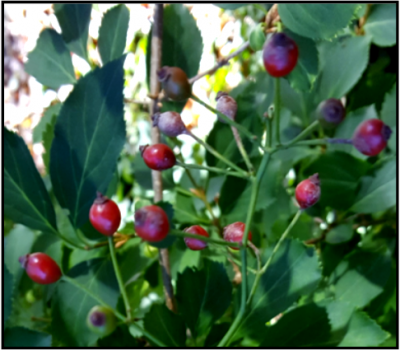
- Cut stump: Immediately after cutting, apply a systemic herbicide (e.g., glyphosate or triclopyr) to freshly cut stems or stumps with a paint brush or sponge applicator. Treatment can be applied anytime during the year when the plant is actively growing; greatest effectiveness will occur in July to mid-September. For best results, cut plants to 6-12 in. in March-June and allow them to resprout. Cut them again to 1 in. and apply herbicide to the cut stumps in July to mid-September.
- Foliar: A systemic herbicide can be applied directly to foliage from July to September. After initial mowing, allow the plant to regrow; apply foliar treatment once regrowth has reached 2-3 ft.
- Refer to Penn State Extension for more details.
Distribution
Multiflora rose is widespread in the northeast United States, the Midwest, and southeastern states, with scattered infestations in California and Oregon.
Other Facts and Background
Multiflora rose is native to China, Japan, and Korea. The plant was introduced to the United States in the 1860s for its ornamental value, was routinely used as root stock for rose breeding programs, and was promoted by the USDA Soil Conservation Service for erosion control. It was frequently used as a ‘living fence’ and touted as a food and cover source for wildlife. By the 1960s, the invasive properties of the plant were well established and the overall effect of the plant on habitat value was determined to be negative.

SOURCES:
- Connecticut Invasive Plants Council. (2018, October). Connecticut Invasive Plant List. cipwg.uconn.edu
- Munger, G. T. (2002). Rosa multiflora. Fire Effects Information System, U.S. Department of Agriculture, Forest Service, Rocky Mountain Research Station, Fire Sciences Laboratory. fs.usda.gov/database/feis/plants/shrub/rosmul/all.html
- New York Invasive Species (IS) Information. (2019, July 2). Multiflora Rose. Cornell Cooperative Extension & SeaGrant New York. nyis.info/invasive_species/multiflora-rose/
- Templeton, S. Gover, A., Jackson, D., & Wurzbacher, S. (Updated 2020, February 24). Multiflora Rose. PennState Extension. extension.psu.edu/multiflora-rose
- Varricchio, E. & Connecticut Invasive Plant Working Group. (n.d.). Connecticut’s Invasive Plant Management Calendar: The Top 10 Invasive Plants [PowerPoint slides]. Connecticut Invasive Plant Working Group. cipwg.uconn.edu
- Wenning, B. (2012, July 16). Multiflora Rose: An Exotic Invasive Plant Fact Sheet. Ecological Landscape Alliance. ecolandscaping.org/07/landscape-challenges/invasive-plants/multiflora-rose-an-exotic-invasive-plant-fact-sheet
Questions? Contact:
Vickie Wallace
UConn Extension
Extension Educator
Sustainable Turf and Landscape
Phone: (860) 885-2826
Email: victoria.wallace@uconn.edu
Web: ipm.uconn.edu/school
UConn Extension is committed to providing equal access and full participation for individuals with disabilities within all our programs and activities. Visit s.uconn.edu/accessibility for more resources. UConn is an equal opportunity program provider and employer.
Funds to support the creation of this document were provided by the Crop Protection and Pest Management Extension Implementation Program [grant no. 2017-70006-27201/project accession no. 1013777] from the USDA National Institute of Food and Agriculture.
©UConn Extension. All rights reserved.
Updated May 2021
  |
